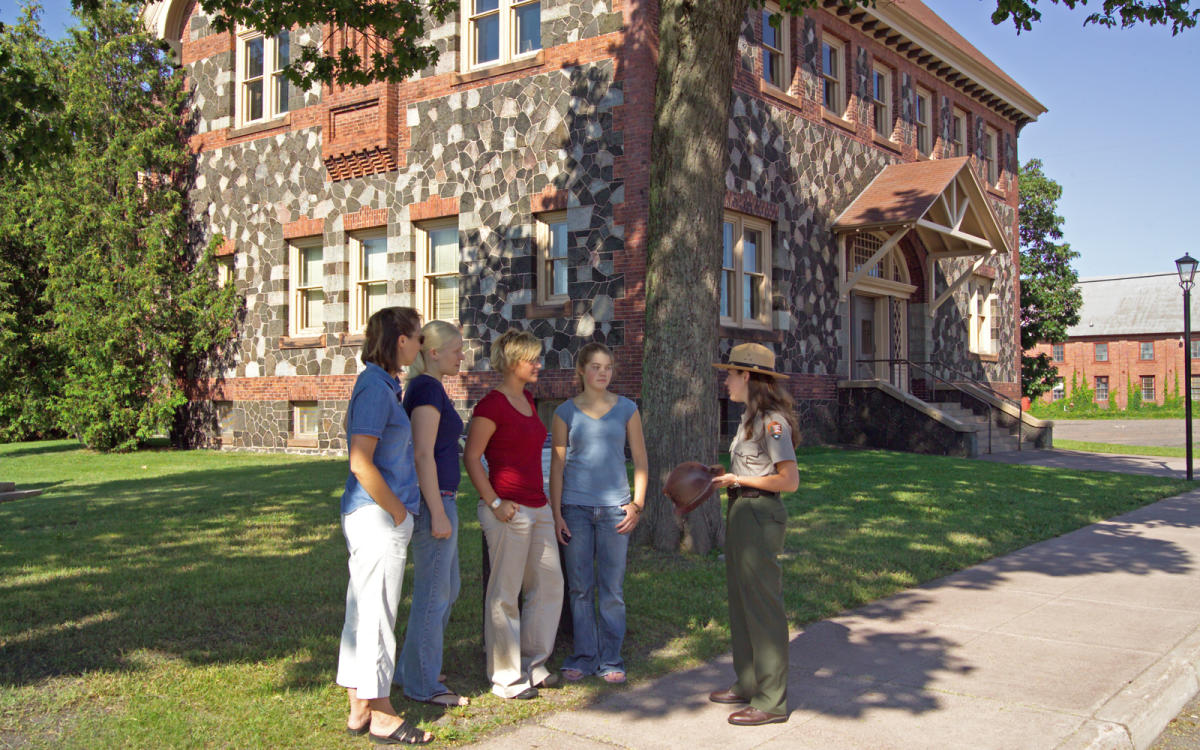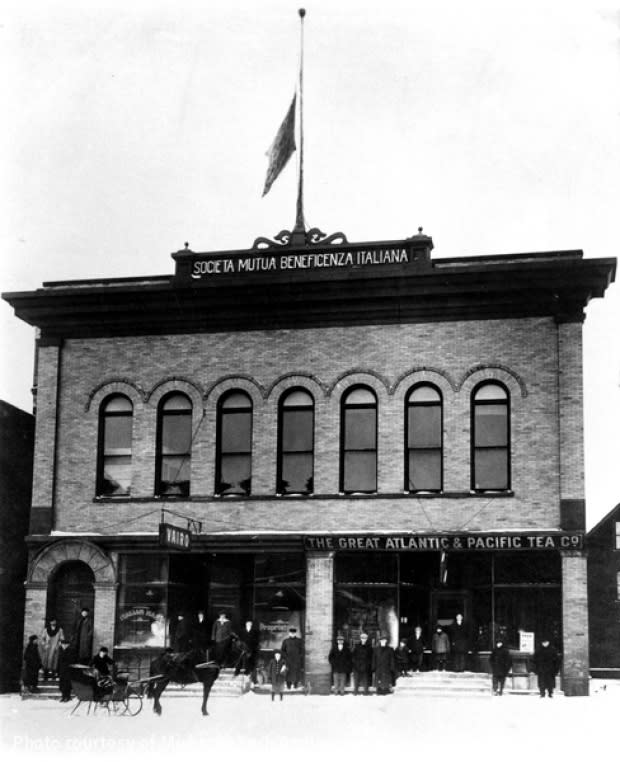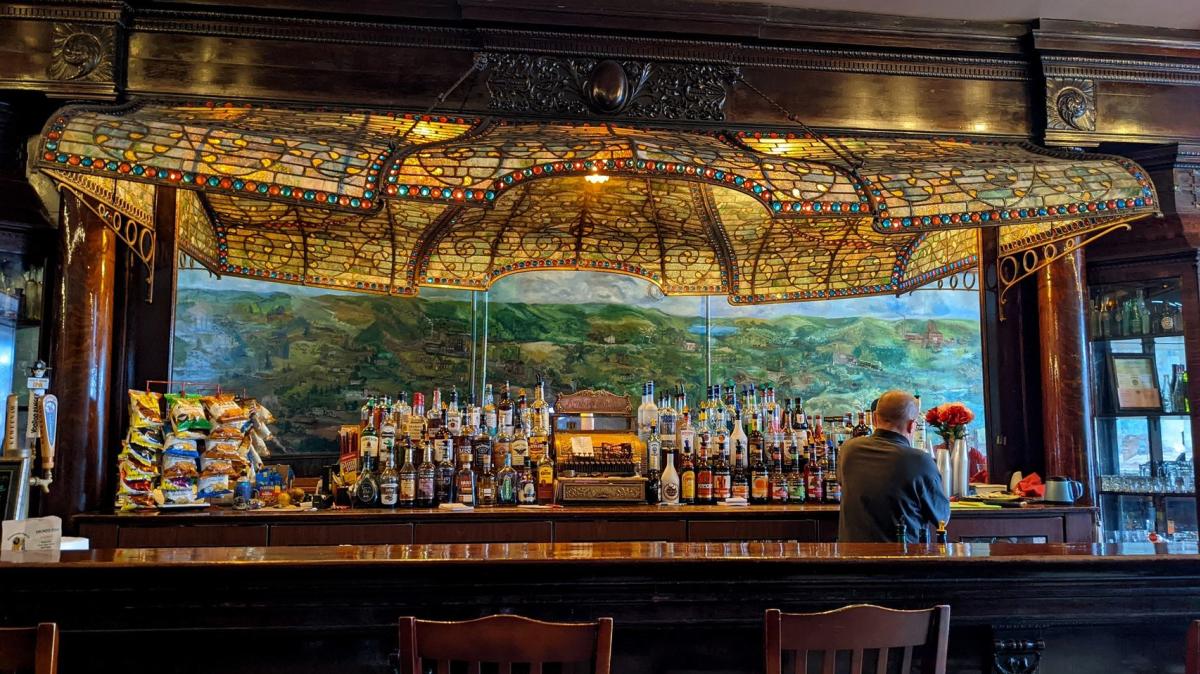Often referred to as the "Copper Country," the Keweenaw Peninsula was the center of the copper mining boom in the United States from the opening of the first mine in 1845 to the closure of the last Keweenaw copper mine in 1968. Copper mining was a dangerous and demanding job that brought tens of thousands of immigrants to the region. Immigrant mine workers had high hopes of a better life for themselves and their families, but the job took a toll on the physical and mental health of many.
In 1913-1914, 25-year-old Anna Klobuchar Clemenc ("Big Annie") of Calumet, MI spearheaded a labor movement to improve the working conditions for miners. This movement became known as the Copper Country Strike of 1913-1914. Follow along as we take you on a tour through historic Calumet, MI, retracing "Big Annie's" footsteps.
"The Women of the Copper Country"
In 2019, Mary Doria Russell's historical fiction, "The Women of the Copper Country" was published, interpreting and preserving the story of Big Annie's involvement in the Copper Country Strike of 1913-1914. This captivating novel has engaged the emotions of readers across the country, keeping Big Annie's legacy alive while sharing the story of Calumet's influential labor strike.
Mary Doria Russell is a New York Times Best Selling Author with a Ph.D. in biological anthropology from the University of Michigan. When asked what inspired "The Women of the Copper Country," she told us, "Just by chance, I saw the PBS documentary "Red Metal' about the 1913 copper miners' strike and mentioned on Facebook that I thought there might be a story for me to tell about how Annie Clements came to be the emblem of the strikers' daily marches. I went from might tell to must tell the story when a dear friend told me that her great grandfather was the last man killed in the mines just before the strike was called."

Big Annie poses with her flag | Image Credit: Keweenaw National Historical Park , C&H, Capello, Strike Album, #164
"The Women of the Copper Country" has inspired many readers to visit and learn more about the Calumet area. The novel painted a vivid portrait of the region, bringing to life the hardships and struggles of mineworkers and their families. For months, Big Annie carried a massive flag down the streets of Calumet, leading daily protests in support of higher wages and better working conditions for mineworkers. Today, you can walk along the same streets and imagine the power of her voice echoing off the buildings around you.
Explore Present-Day Calumet
Driving into Calumet is like taking a trip back in time. By 1890, Calumet (formerly Red Jacket) was a bustling cosmopolitan of 60,000 residents. Now, it is a small village filled with relics of the past and an area population closer to 2,000. The same red sandstone buildings of Big Annie's time still line the streets, and mining artifacts and towering smokestacks hint at the by-gone era of the copper mining industry.

Calumet retains much of its original appearance thanks to ongoing preservation efforts.
Thanks to ongoing preservation efforts, Calumet's downtown area retains much of its original appearance and character. The downtown district is also listed in the National Register of Historic Places and as a National Historic Landmark. The Village of Calumet embraces its unique history and heritage, and it's evident that locals put in the effort to keep individual stories and legacies alive.
Here are our top recommendations for a weekend spent exploring Calumet's history and Annie's story as described in "The Women of the Copper Country." Please note that some of these attractions are seasonal, with many opening around mid-May.
Keweenaw National Historical Park
Established in 1992, the Keweenaw National Historical Park (KNHP) preserves and interprets the history of the copper mining industry and its effect on the people and the land. While the park includes several Heritage Sites spanning the length of the Keweenaw Peninsula, the park Headquarters & Visitors Center is located within the historic district of Calumet on 5th Street.
Housed in the 1889 Union Building, the KNHP Visitor's Center features interactive museum exhibits, artifacts from the past, and ranger-led tours through Calumet during the summer. The museum serves as an excellent starting point for those looking to step back in time and learn more about the impact of the copper mining industry.

The KNHP offers ranger-led tours of Calumet's historic district during the summer months.
Coppertown Mining Museum
The Coppertown Mining Museum also offers educational exhibits that dive deep into the history of copper mining in the Keweenaw Peninsula. One special exhibit shares the story of Anna Clemenc and includes an award of notoriety from the Labor's International Hall of Fame that was donated by descendants of Big Annie's family. The museum also features the two-man drill, foundry and metal casting, antique hospital equipment, and pump and ore cars.
Italian Hall Memorial
On Christmas Eve 1913, tragedy occurred at the Italian Hall. The Italian Hall was hosting a Christmas party on the second floor, when a false cry of "fire" incited panic. As people rushed down the stairway to exit the building, 73 were killed, including 59 children.
The party was sponsored by the Western Federation of Miner's Ladies Auxiliary (which Annie led), and many striking miners and their families were in attendance. It is widely believed that the man who yelled "fire" was wearing a badge for Citizen's Alliance, an organization that opposed trade unions and strikes. The devastation of the Italian Hall Disaster was unimaginable, and to happen against the backdrop of nasty labor strike made it a tragedy that our community will always remember. In the days following the incident, Big Annie led a funeral procession to Lakeview Cemetery where the victims were laid to rest.

Italian Hall - Entrance to Hall on far left. | Photo Courtesy of MTU Archives (Donor Raymond Smith)
The Italian Hall was demolished in October 1984 and a memorial park was created with the original stone archway repositioned in the center of the lot. Every Christmas Eve, community members gather to honor and remember the victims of the tragedy. A luminary is lit for each victim, and the fire hall bell is rung at 4:30, the same time that the bell rang to announce the tragedy on Christmas Eve in 1913.
Copper Country Firefighters History Museum
Built in 1898, the Copper Country Firefighters History Museum served as the Calumet Fire Station until the early 1960's. This large red sandstone building still features the original fire alarm box that was mounted on the building in 1898. This is part of the fire alarm system that was placed by the Calumet & Hecla Mining Company in 1892. The alarm is sounded at 12:30PM everyday throughout the year.

The Copper Country Firefighters History Museum offers 2 floors of exhibits.
The interior of the museum features two floors of old fire trucks, artifacts, photos, and exhibits. The second floor of the museum now includes an Italian Hall Exhibit, within view of the actual site where the incident took place. The exhibit shares the story of the "Death Doors" controversy regarding whether the doors opened inward or outward. According to some scholars and historians, if the doors opened inward, fleeing partygoers would have pressed up against the doors, preventing them from opening and causing many people to be crushed. If the doors opened outward, it would have been easier for victims to escape to the street. This has been a widely studied topic for years, and some individuals may still disagree. However, documents and photographs from the time point to the conclusion that the doors were double-hinged and opened to the street. Read more about the controversy here.
The original State Historical Marker at the Italian Hall Memorial Park said, "the doors opened inward," but since the controversy continues, the State replaced the marker without this text. The original State Historical Marker and salvaged doors from the Italian Hall are now the main component of this exhibit.
Shute's 1890 Saloon
At a time when over 30 languages could be heard on the streets of Calumet, saloons served as important social centers for immigrant groups. In fact, by 1908, there were 78 bars in Calumet. Shute's happened to be an Italian Men's Club, owned by Italian-born Marco Curto, and was called Curto's Saloon. With rich history dating back to the 1890's, Shute's serves as an example of what the bar scene was like during the peak of the copper mining boom. One of the highlights of Shute's is the incredible Brunswick stained-glass canopy overhanging the backbar.

Shute's retains much of its original character, including the Brunswick stained-glass canopy over the back bar.
Shute's offers a variety of can/bottle choices, cocktails, and draft beer. The tap list always features local Keweenaw Brewing Company beer, including the "Widowmaker" which pays homage to the Copper Country Mine Strike of 1913-1914. One of the goals of the mine strike was to eliminate the use of one-man drills. These one-man drills were often referred to as "Widowmakers," as they were extremely dangerous to use.
Calumet Theatre
Adjacent to Shute's is the Calumet Theatre. The Calumet Theatre is the oldest municipally built and owned theater in the country and is on the National Register of Historic Places. This turn of the century theatre is architecturally stunning, with exquisite fine details, balcony seating, detailed paintings above the stage, and built-in acoustics. It offers a glimpse into the fine aesthetics of the time.

Calumet Theatre features exquisite details and quality entertainment.
During the early 1900's, many famous actors and actresses performed on the stage. And when it came time for intermission, theatregoers would often head to Curto's Saloon for a drink. At one point, the Calumet Theatre box office had control of a signal light in the saloon to call the audience back when it was time for the show to resume. Today, the theatre continues to offer a quality entertainment and offers a variety of shows, movies, and events throughout the year.
Mineral Range Depot
Although the Mineral Range Depot is vacant now, it remains a significant landmark and a worthy photo-opportunity. Located on the corner of 9th and Oak, the depot served as a gateway to Calumet for thousands of immigrants and visitors. Built in 1908, the station once connected Calumet to faraway cities like Chicago and Milwaukee. In August 1913, it even served as the entry-point for labor organizer and activist, Mother Jones during her visit to Calumet in support of the ongoing strike.

Postcard view of the Depot, ca. 1915 | Image source Main Street Calumet
Sites to Explore Near Calumet
Laurium Manor Inn
While technically in present-day Laurium, the Laurium Manor Inn is an important destination for those interested in understanding the wealth of mine owners during the peak of the copper mining boom. This beautiful mansion was built in 1908 for Thomas H. (owner of Calumet & Arizona Mining Company) and his wife Corneila Hoaston.
Featuring a Neoclassical design and lavish details in every room, this 13,000 square foot mansion is must-see. From the silver leaf covered domed ceiling in the music parlor, to gilded and embossed elephant leather wall coverings and stained glass in the dining room, no expense was spared in the building of this 45-room home. The mansion also includes a grand triple staircase of carved oak, panoramic hand-painted murals, a 1,300 square foot ballroom, and a 100-foot-long tile wraparound porch.

The Laurium Manor Inn is an excellent example of the wealth of mine owners and the income disparity between mine workers and their superiors.
Today, the Laurium Manor Inn serves as a unique B&B experience where guests can enjoy the opulent luxuries of an early 1900's mine owner. The mansion is also open to the public during the summer for self-guided tours.
Note: Calumet & Laurium are neighboring towns with an intertwined history. Originally, Laurium was known as Calumet, while present-day Calumet was referred to as Red Jacket. Each location was named after a mining company. Read more about this history here.
Company-Owned Mine Houses
As mentioned in Russell's novel, the Calumet & Hecla Mining Company built hundreds of company houses and rented them to married employees at low costs. They also allowed employees to build about 1,000 houses on rented Calumet and Hecla land. These houses were built in rows and can easily be distinguished by their old rock foundations and straight, simple design. Nearly all houses included a vestibule or "snow room" where miners and their families would remove their outdoor or mine clothing before entering the home.
Employees and their families were dependent on the goodwill of the mining companies to provide housing, creating additional tension during the mine strikes. In addition to controlling housing, mining companies also controlled, schools, hospitals, local government, and provided free land to build churches. While only a fraction of company-owned homes still exist, they can still be seen throughout the region. Many of them have been renovated and updated using modern building materials.
Mine Tour
To get a better understanding of the mining process and what conditions were like for miners, we recommend taking a mine tour. While there are no mine tours in Calumet, there are a few nearby. Take the cogwheel tram underground for an informative guided tour at Quincy Mine in Hancock. Or go at your own pace by taking a self-guided tour of the Delaware Mine on your way up to Copper Harbor.

Mine tours offer valuable insight into what life was like for miners working underground in the Keweenaw.
Grab a Pasty
After your mine tour, we recommend grabbing a pasty (pronounced past-ee). A pasty is a folded case with a savory filling, typically of seasoned meat and vegetables and was introduced to the Keweenaw by Cornish immigrants. These travel-ready, hearty meals were a common lunch for hard-working miners and were packed in metal lunch pails. The pasty has become a cultural point of pride and can be found at several restaurants throughout the Keweenaw Peninsula.
Keeping Legacy Alive - Big Annie Statue Fund
A local advisory committee has formed with the goal of raising funds to build a bronze statue of Big Annie in Calumet, MI. The Keweenaw Community Foundation is accepting donations for the project. Annie was an influential leader in our area and a notable activist in the development of the U.S. labor movement. A statue of "Big Annie" would help commemorate this historic woman, honor her legacy, and pass along her story to generations to come.
Interested in updates, travel tips and quirky information about the Keweenaw? Just sign up for the Keweenaw Explorer, our monthly e-newsletter. Complete the form…

